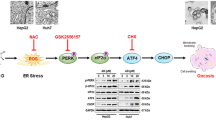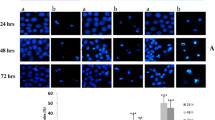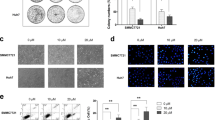Abstract
The endoplasmic reticulum (ER) is a central organelle in eukaryotic cells that functions in protein synthesis and maturation, and also functions as a calcium storage organelle. Perturbation of ER functions leads to ER stress, which has been previously associated with a broad variety of diseases. ER stress is generally regarded as compensatory, but prolonged ER stress can activate apoptotic pathways in damaged cells. For this reason, pharmacological interventions that effectively enhance tumor death through ER stress have been the subject of a great deal of attention for anti-cancer therapy. Cryptotanshinone, the major active constituent isolated from the root of Salvia miltiorrhiza Bunge, has been recently evaluated for its anti-cancer activity, but the molecular mechanisms underlying these activities remain poorly understood. In particular, it remains completely unknown as to whether or not cryptotanshinone can induce ER stress. Herein, we identify cryptotanshinone as a potent stimulator of ER stress, leading to apoptosis in many cancer cell lines, including HepG2 hepatoma and MCF7 breast carcinoma, and also demonstrate that mitogen-activated protein kinases function as mediators in this process. Reactive oxygen species generated by cryptotanshinone have been shown to play a critical role in ER stress-induced apoptosis. Cryptotanshinone also evidenced sensitizing effects to a broad range of anti-cancer agents including Fas/Apo-1, TNF-α, cisplatin, etoposide or 5-FU through inducing ER stress, highlighting the therapeutic potential in the treatment of human hepatoma and breast cancer.






Similar content being viewed by others
References
Gorlach A, Klappa P, Kietzmann T (2006) The endoplasmic reticulum: folding, calcium homeostasis, signaling, and redox control. Antioxid Redox Signal 8:1391–1418
Brostrom MA, Brostrom CO (2003) Calcium dynamics and endoplasmic reticular function in the regulation of protein synthesis: implications for cell growth and adaptability. Cell Calcium 34:345–363
Hosoi T, Ozawa K (2010) Endoplasmic reticulum stress in disease: mechanisms and therapeutic opportunities. Clin Sci Lond 118:19–29
Kozutsumi Y, Segal M, Normington K, Gething MJ, Sambrook J (1988) The presence of malfolded proteins in the endoplasmic reticulum signals the induction of glucose-regulated proteins. Nature 332:462–464
Shore GC, Papa FR, Oakes SA (2011) Signaling cell death from the endoplasmic reticulum stress response. Curr Opin Cell Biol 23:143–149
Breckenridge DG, Germain M, Mathai JP, Nguyen M, Shore GC (2003) Regulation of apoptosis by endoplasmic reticulum pathways. Oncogene 22:8608–8618
Herr I, Debatin KM (2001) Cellular stress response and apoptosis in cancer therapy. Blood 98:2603–2614
Kim I, Shu CW, Xu W et al (2009) Chemical biology investigation of cell death pathways activated by endoplasmic reticulum stress reveals cytoprotective modulators of ASK1. J Biol Chem 284:1593–1603
Szegezdi E, Logue SE, Gorman AM, Samali A (2006) Mediators of endoplasmic reticulum stress-induced apoptosis. EMBO Rep 7:880–885
Li J, Lee B, Lee AS (2006) Endoplasmic reticulum stress-induced apoptosis: multiple pathways and activation of p53-up-regulated modulator of apoptosis (PUMA) and NOXA by p53. J Biol Chem 281:7260–7270
Salazar M, Carracedo A, Salanueva IJ et al (2009) Cannabinoid action induces autophagy-mediated cell death through stimulation of ER stress in human glioma cells. J Clin Invest 119:1359–1372
Armstrong JL, Flockhart R, Veal GJ, Lovat PE, Redfern CP (2010) Regulation of endoplasmic reticulum stress-induced cell death by ATF4 in neuroectodermal tumor cells. J Biol Chem 285:6091–6100
Healy SJ, Gorman AM, Mousavi-Shafaei P, Gupta S, Samali A (2009) Targeting the endoplasmic reticulum-stress response as an anticancer strategy. Eur J Pharmacol 625:234–246
Jin DZ, Yin LL, Ji XQ, Zhu XZ (2006) Cryptotanshinone inhibits cyclooxygenase-2 enzyme activity but not its expression. Eur J Pharmacol 549:166–172
Kim EJ, Jung SN, Son KH et al (2007) Antidiabetes and antiobesity effect of cryptotanshinone via activation of AMP-activated protein kinase. Mol Pharmacol 72:62–72
Mosaddik MA (2003) In vitro cytotoxicity of tanshinones isolated from Salvia miltiorrhiza Bunge against P388 lymphocytic leukemia cells. Phytomedicine 10:682–685
Suh SJ, Jin UH, Choi HJ et al (2006) Cryptotanshinone from Salvia miltiorrhiza BUNGE has an inhibitory effect on TNF-alpha-induced matrix metalloproteinase-9 production and HASMC migration via down-regulated NF-kappaB and AP-1. Biochem Pharmacol 72:1680–1689
Dat NT, Jin X, Lee JH et al (2007) Abietane diterpenes from Salvia miltiorrhiza inhibit the activation of hypoxia-inducible factor-1. J Nat Prod 70:1093–1097
Shin DS, Kim HN, Shin KD et al (2009) Cryptotanshinone inhibits constitutive signal transducer and activator of transcription 3 function through blocking the dimerization in DU145 prostate cancer cells. Cancer Res 69:193–202
Lee WY, Liu KW, Yeung JH (2009) Reactive oxygen species-mediated kinase activation by dihydrotanshinone in tanshinones-induced apoptosis in HepG2 cells. Cancer Lett 285:46–57
Ye Y, Xu W, Zhong W (2010) Effects of cryptotanshinone on proliferation and apoptosis of HeLa cell line of cervical cancer. Zhongguo Zhong Yao Za Zhi 35:118–121
Chen W, Luo Y, Liu L et al (2010) Cryptotanshinone inhibits cancer cell proliferation by suppressing Mammalian target of rapamycin-mediated cyclin D1 expression and Rb phosphorylation. Cancer Prev Res Phila 3:1015–1025
Hur JM, Shim JS, Jung HJ, Kwon HJ (2005) Cryptotanshinone but not tanshinone IIA inhibits angiogenesisin vitro. Exp Mol Med 37:133–137
Nagai H, Noguchi T, Takeda K, Ichijo H (2007) Pathophysiological roles of ASK1-MAP kinase signaling pathways. J Biochem Mol Biol 40:1–6
Sekine Y, Takeda K, Ichijo H (2006) The ASK1-MAP kinase signaling in ER stress and neurodegenerative diseases. Curr Mol Med 6:87–97
Indran IR, Tufo G, Pervaiz S, Brenner C (2011) Recent advances in apoptosis, mitochondria and drug resistance in cancer cells. Biochim Biophys Acta 1807:735–745
Igney FH, Krammer PH (2002) Death and anti-death: tumour resistance to apoptosis. Nat Rev Cancer 2:277–288
Srivastava RK, Sasaki CY, Hardwick JM, Longo DL (1999) Bcl-2-mediated drug resistance: inhibition of apoptosis by blocking nuclear factor of activated T lymphocytes (NFAT)-induced Fas ligand transcription. J Exp Med 190:253–265
Kawahara A, Kobayashi T, Nagata S (1998) Inhibition of Fas-induced apoptosis by Bcl-2. Oncogene 17:2549–2554
Straszewski-Chavez SL, Abrahams VM, Funai EF, Mor G (2004) X-linked inhibitor of apoptosis (XIAP) confers human trophoblast cell resistance to Fas-mediated apoptosis. Mol Hum Reprod 10:33–41
Osawa T, Muramatsu M, Watanabe M, Shibuya M (2009) Hypoxia and low-nutrition double stress induces aggressiveness in a murine model of melanoma. Cancer Sci 100:844–851
Lee AS (2001) The glucose-regulated proteins: stress induction and clinical applications. Trends Biochem Sci 26:504–510
Kitamura M (2008) Endoplasmic reticulum stress and unfolded protein response in renal pathophysiology: Janus faces. Am J Physiol Renal Physiol 295:323–334
Xu C, Bailly-Maitre B, Reed JC (2005) Endoplasmic reticulum stress: cell life and death decisions. J Clin Invest 115:2656–2664
Seger R, Krebs EG (1995) The MAPK signaling cascade. FASEB J 9:726–735
Wada T, Penninger JM (2004) Mitogen-activated protein kinases in apoptosis regulation. Oncogene 23:2838–2849
Han JY, Fan JY, Horie Y et al (2008) Ameliorating effects of compounds derived from Salvia miltiorrhiza root extract on microcirculatory disturbance and target organ injury by ischemia and reperfusion. Pharmacol Ther 117:280–295
Debatin KM, Krammer PH (2004) Death receptors in chemotherapy and cancer. Oncogene 23:2950–2966
Kruyt FA (2008) TRAIL and cancer therapy. Cancer Lett 263:14–25
Mahmood Z, Shukla Y (2010) Death receptors: targets for cancer therapy. Exp Cell Res 316:887–899
Kim JH, Jeong SJ, Kwon TR et al (2011) Cryptotanshinone enhances TNF-alpha-induced apoptosis in chronic myeloid leukemia KBM-5 cells. Apoptosis 16:696–707
Park IJ, Kim MJ, Park OJ et al (2010) Cryptotanshinone sensitizes DU145 prostate cancer cells to Fas(APO1/CD95)-mediated apoptosis through Bcl-2 and MAPK regulation. Cancer Lett 298:88–98
Acknowledgments
This work was supported by the National Research Foundation of Korea (NRF) grant funded by the Korea government (MEST) (No. 2011-0030722).
Conflict of interest
No conflict of interest is declared.
Author information
Authors and Affiliations
Corresponding author
Rights and permissions
About this article
Cite this article
Park, IJ., Kim, MJ., Park, O.J. et al. Cryptotanshinone induces ER stress-mediated apoptosis in HepG2 and MCF7 cells. Apoptosis 17, 248–257 (2012). https://doi.org/10.1007/s10495-011-0680-3
Published:
Issue Date:
DOI: https://doi.org/10.1007/s10495-011-0680-3




